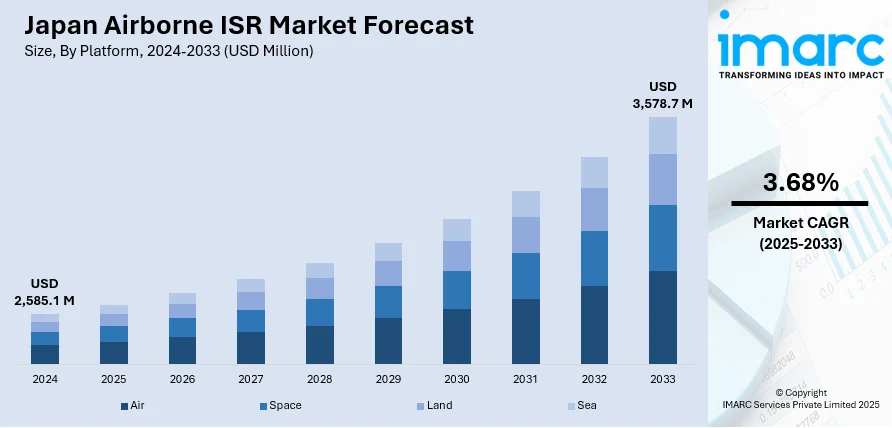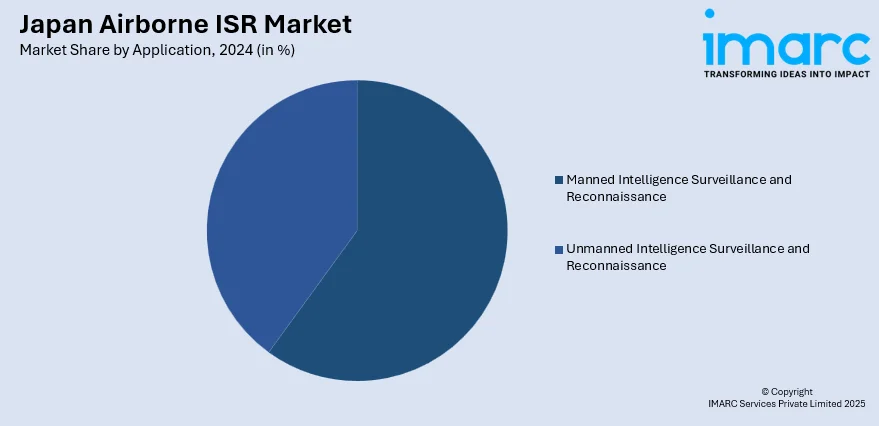
Japan Airborne ISR Market Size, Share, Trends and Forecast by Platform, System, Type, Fuel Type, Application, and Region, 2025-2033
Japan Airborne ISR Market Overview:
The Japan airborne ISR market size reached USD 2,585.1 Million in 2024. Looking forward, IMARC Group expects the market to reach USD 3,578.7 Million by 2033, exhibiting a growth rate (CAGR) of 3.68% during 2025-2033. The market is driven by regional security tensions, the need for maritime domain awareness, and advancements in sensor technologies. Government modernization programs, increased defense spending, and collaboration with the U.S. for interoperability further accelerate investment. Emphasis on early warning, surveillance, and integrated threat detection remains central.
|
Report Attribute
|
Key Statistics
|
|---|---|
|
Base Year
|
2024 |
|
Forecast Years
|
2025-2033
|
|
Historical Years
|
2019-2024
|
| Market Size in 2024 | USD 2,585.1 Million |
| Market Forecast in 2033 | USD 3,578.7 Million |
| Market Growth Rate 2025-2033 | 3.68% |
Japan Airborne ISR Market Trends:
Expansion of ISR Capabilities for Maritime Surveillance
Japan continues to invest in airborne ISR assets focused on maritime surveillance, particularly in the East China Sea and Pacific Ocean. Given the rising frequency of unauthorized incursions near the Senkaku Islands and contested sea lanes, enhancing wide-area domain awareness has become a defense priority. The deployment of advanced platforms intent to monitor maritime zones comprehensively, offering long-range surveillance, high-altitude performance, and the ability to track multiple targets simultaneously. The emphasis on persistent maritime ISR aligns with Japan’s efforts to deter gray-zone activities and protect territorial integrity, while also reinforcing its capabilities under multilateral security arrangements like the Quad and the U.S.-Japan alliance. For instance, in August 2024, the U.S. Marine Corps deployed up to six MQ-9 Reaper UAVs to Kadena Air Base in Okinawa for a year-long ISR mission, enhancing surveillance around Japan’s southwest region. This move, aligned with Japan-U.S. security cooperation, follows increasing regional tensions, particularly from China near the Senkaku Islands. The Reapers, assigned to VMU-3, will operate unarmed and support joint training and reconnaissance efforts. Meanwhile, Japan continues evaluating MQ-9B SeaGuardian UAVs for potential integration into its maritime surveillance operations.

Integration of Indigenous Technologies into ISR Platforms
A key trend in Japan’s airborne ISR strategy is the integration of domestically developed technologies to enhance platform autonomy and reduce reliance on foreign systems. Companies such as Mitsubishi Electric and NEC are contributing to radar, signal processing, and data-link solutions customized for the Japanese Self-Defense Forces. This focus supports national policy goals of defense industrial independence and innovation. The inclusion of indigenous mission systems in platforms underscore the government's commitment to sustaining its defense R&D ecosystem. These initiatives also support cybersecurity and operational secrecy by minimizing external supply chain exposure. Additionally, homegrown solutions facilitate quicker system upgrades and better alignment with Japan’s specific ISR mission requirements. For instance, Japan plans to deploy the upgraded Type-12 ground-based anti-ship missile in fiscal year 2025, expanding its strike range to over 900 km. Developed by Mitsubishi Heavy Industries, the missile highlights Japan’s focus on indigenous defense capabilities amid regional tensions. Positioned in the Ryukyu Islands, it aims to deter China’s naval activity near the Senkaku Islands. Japan is also investing in ISR infrastructure, including a new satellite constellation and greater cooperation with the U.S. and South Korea, enhancing long-range targeting and surveillance coordination.
Transition to Multi-Domain ISR Coordination
Japan is shifting toward a multi-domain ISR approach that integrates airborne platforms with space-based assets, ground stations, and naval systems. This model enhances situational awareness and supports joint operations across air, sea, cyber, and space domains. The development of centralized command structures and real-time data fusion hubs is underway to ensure seamless coordination. Airborne ISR systems are being adapted to feed into broader C4ISR networks, leveraging artificial intelligence for target recognition and threat prioritization. The aim is to achieve quicker decision cycles and synchronized responses across forces. This transformation supports Japan’s evolving defense doctrine that emphasizes deterrence, rapid response, and integration with allied intelligence frameworks for regional stability. For instance, in December 2024, Japan’s Defense Ministry plans to purchase 23 additional U.S.-made SeaGuardian MQ-9B drones to expand its maritime ISR capabilities, supplementing the three already in use by the Coast Guard. These uncrewed aircraft offer extended endurance, cost efficiency, and wide-area surveillance reach. The drones will also support search and rescue, disaster response, and law enforcement missions, aligning with Japan’s multilateral interoperability goals.
Japan Airborne ISR Market Segmentation:
IMARC Group provides an analysis of the key trends in each segment of the market, along with forecasts at the country and regional levels for 2025-2033. Our report has categorized the market based on platform, system, type, fuel type, and application.
Platform Insights:
- Air
- Space
- Land
- Sea
The report has provided a detailed breakup and analysis of the market based on the platform. This includes air, space, land, and sea.
System Insights:
- Maritime Patrol
- Electronic Warfare
- Airborne Early Warning and Control (AEWC)
- Airborne Ground Surveillance (AGS)
- Signals Intelligence (SIGINT)
A detailed breakup and analysis of the market based on the system have also been provided in the report. This includes maritime patrol, electronic warfare, airborne early warning and control (AEWC), airborne ground surveillance (AGS), and signals intelligence (SIGINT).
Type Insights:
- Surveillance
- Reconnaissance
- Intelligence
A detailed breakup and analysis of the market based on the type have also been provided in the report. This includes surveillance, reconnaissance, and intelligence.
Fuel Type Insights:
- Hydrogen Fuel-Cells
- Solar Powered
- Alternate Fuel
- Battery Operated
- Gas-Electric Hybrids
A detailed breakup and analysis of the market based on the fuel type have also been provided in the report. This includes hydrogen fuel-cells, solar powered, alternate fuel, battery operated, and gas-electric hybrids.
Application Insights:

- Manned Intelligence Surveillance and Reconnaissance
- Unmanned Intelligence Surveillance and Reconnaissance
A detailed breakup and analysis of the market based on the application have also been provided in the report. This includes manned intelligence surveillance and reconnaissance and unmanned intelligence surveillance and reconnaissance.
Regional Insights:
- Kanto Region
- Kansai/Kinki Region
- Central/ Chubu Region
- Kyushu-Okinawa Region
- Tohoku Region
- Chugoku Region
- Hokkaido Region
- Shikoku Region
The report has also provided a comprehensive analysis of all the major regional markets, which include Kanto, Kansai/Kinki, Central/ Chubu, Kyushu-Okinawa, Tohoku, Chugoku, Hokkaido, and Shikoku Region.
Competitive Landscape:
The market research report has also provided a comprehensive analysis of the competitive landscape. Competitive analysis such as market structure, key player positioning, top winning strategies, competitive dashboard, and company evaluation quadrant has been covered in the report. Also, detailed profiles of all major companies have been provided.
Japan Airborne ISR Market News:
- In January 2025, the Japan Maritime Self-Defense Force (JMSDF) selected the V-BAT unmanned aircraft system (UAS) from Shield AI as its first maritime-based ISR platform. The deal initiates a multi-year procurement plan aimed at equipping JMSDF vessels with advanced ISR capabilities. V-BAT’s vertical takeoff and landing (VTOL) design enables deployment in confined shipborne settings. Known for reliability even in GPS- and communications-denied environments, V-BAT enhances maritime surveillance and targeting operations, supporting Japan's defense readiness and Indo-Pacific security posture through autonomous, cost-effective ISR solutions.
- In December 2024, the Japan Maritime Self-Defense Force (JMSDF) selected General Atomics Aeronautical Systems Inc.'s (GA-ASI) SeaGuardian unmanned aircraft system for its Long Endurance UAV program. SeaGuardian, a medium-altitude long-endurance platform, provides 24+ hour ISR capabilities with advanced multi-mode radar, optical and infrared sensors, and electronic intelligence tools. GA-ASI’s Optix+ software enhances maritime surveillance by integrating and analyzing multi-source data for real-time situational awareness. The system supports automatic vessel detection, tracking, and anomaly identification, expanding JMSDF’s maritime domain awareness capabilities.
Japan Airborne ISR Market Report Coverage:
| Report Features | Details |
|---|---|
| Base Year of the Analysis | 2024 |
| Historical Period | 2019-2024 |
| Forecast Period | 2025-2033 |
| Units | Million USD |
| Scope of the Report |
Exploration of Historical Trends and Market Outlook, Industry Catalysts and Challenges, Segment-Wise Historical and Future Market Assessment:
|
| Platforms Covered | Air, Space, Land, Sea |
| Systems Covered | Maritime Patrol, Electronic Warfare, Airborne Early Warning and Control (AEWC), Airborne Ground Surveillance (AGS), Signals Intelligence (SIGINT) |
| Types Covered | Surveillance, Reconnaissance, Intelligence |
| Fuel Types Covered | Hydrogen Fuel-Cells, Solar Powered, Alternate Fuel, Battery Operated, Gas-Electric Hybrids |
| Applications Covered | Manned Intelligence Surveillance and Reconnaissance, Unmanned Intelligence Surveillance and Reconnaissance |
| Regions Covered | Kanto Region, Kansai/Kinki Region, Central/Chubu Region, Kyushu-Okinawa Region, Tohoku Region, Chugoku Region, Hokkaido Region, Shikoku Region |
| Customization Scope | 10% Free Customization |
| Post-Sale Analyst Support | 10-12 Weeks |
| Delivery Format | PDF and Excel through Email (We can also provide the editable version of the report in PPT/Word format on special request) |
Key Questions Answered in This Report:
- How has the Japan airborne ISR market performed so far and how will it perform in the coming years?
- What is the breakup of the Japan airborne ISR market on the basis of platform?
- What is the breakup of the Japan airborne ISR market on the basis of system?
- What is the breakup of the Japan airborne ISR market on the basis of type?
- What is the breakup of the Japan airborne ISR market on the basis of fuel type?
- What is the breakup of the Japan airborne ISR market on the basis of application?
- What are the various stages in the value chain of the Japan airborne ISR market?
- What are the key driving factors and challenges in the Japan airborne ISR market?
- What is the structure of the Japan airborne ISR market and who are the key players?
- What is the degree of competition in the Japan airborne ISR market?
Key Benefits for Stakeholders:
- IMARC’s industry report offers a comprehensive quantitative analysis of various market segments, historical and current market trends, market forecasts, and dynamics of the Japan airborne ISR market from 2019-2033.
- The research report provides the latest information on the market drivers, challenges, and opportunities in the Japan airborne ISR market.
- Porter's five forces analysis assist stakeholders in assessing the impact of new entrants, competitive rivalry, supplier power, buyer power, and the threat of substitution. It helps stakeholders to analyze the level of competition within the Japan airborne ISR industry and its attractiveness.
- Competitive landscape allows stakeholders to understand their competitive environment and provides an insight into the current positions of key players in the market.
Need more help?
- Speak to our experienced analysts for insights on the current market scenarios.
- Include additional segments and countries to customize the report as per your requirement.
- Gain an unparalleled competitive advantage in your domain by understanding how to utilize the report and positively impacting your operations and revenue.
- For further assistance, please connect with our analysts.
 Request Customization
Request Customization
 Speak to an Analyst
Speak to an Analyst
 Request Brochure
Request Brochure
 Inquire Before Buying
Inquire Before Buying




.webp)




.webp)












